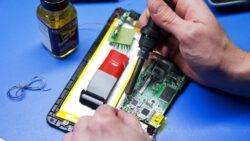The EU wants to prevent manufacturers from making it difficult for consumers to change their devices’ batteries safely and cheaply.
Imagine being able to replace the battery of your cell phone, computer or tablet yourself without difficulty — this is the goal of the new European regulation on batteries, which aims to facilitate the processing of this waste and make the economy more circular.
By 2027, end users must be able to remove and replace the batteries installed in these devices.
Manufacturers sometimes use tricks to make this more difficult, as Areg Badalian who runs Fix Fox, a Brussels shop that repairs electronic devices, told Euronews.
“Every time we take out a battery, we heat the back a little bit to make it (the electronics) a little bit more flexible so that when we take it out, we don’t tear off other components. For example, the camera comes off when you do that. So you have to be careful, you have to avoid little pitfalls like that.”
The regulations state that changing a battery must not require heat or a solvent to disassemble it. Nor shall the user have to resort to special tools.
“For example, some brands invent screwdrivers and screwdriver shapes so they can’t be repaired, but that’s not very smart because it simply creates a new screwdriver,” Badalian said.
Manufacturers can still use smaller components of the battery to make repairs more difficult, however.
They can also include a programme in their phones that gives a warning message to indicate that it is not an official battery, a message that often confuses consumers.
The goal of this regulation is to make repair, collection and recycling easier.
By 2027, 63% of device batteries must be collected, the Eu regulation stipulates. This should help reduce e-waste, as more than 150 million smartphones are thrown away each year.





